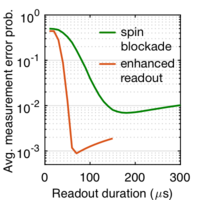Abstract
The readout of semiconductor spin qubits based on spin blockade is fast but suffers from a small charge signal. Previous work suggested large benefits from additional charge mapping processes; however, uncertainties remain about the underlying mechanisms and achievable fidelity. In this work, we study the single-shot fidelity and limiting mechanisms for two variations of an enhanced latching readout. We achieve average single-shot readout fidelities greater than 99.3% and 99.86% for the conventional and enhanced readout, respectively, the latter being the highest to date for spin blockade. The signal amplitude is enhanced to a full one-electron signal while preserving the readout speed. Furthermore, layout constraints are relaxed because the charge sensor signal is no longer dependent on being aligned with the conventional (2,0)–(1,1) charge dipole. Silicon donor-quantum-dot qubits are used for this study, for which the dipole insensitivity substantially relaxes donor placement requirements. One of the readout variations also benefits from a parametric lifetime enhancement by replacing the spin-relaxation process with a charge-metastable one. This provides opportunities to further increase the fidelity. The relaxation mechanisms in the different regimes are investigated. This work demonstrates a readout that is fast, has a one-electron signal, and results in higher fidelity. It further predicts that going beyond 99.9% fidelity in a few microseconds of measurement time is within reach.
- Received 4 August 2017
- Revised 31 January 2018
DOI:https://doi.org/10.1103/PhysRevX.8.021046
Published by the American Physical Society under the terms of the Creative Commons Attribution 4.0 International license. Further distribution of this work must maintain attribution to the author(s) and the published article’s title, journal citation, and DOI.
Published by the American Physical Society
Physics Subject Headings (PhySH)
Popular Summary
Quantum computers promise to solve certain problems much more efficiently than their classical counterparts. Electron spins can be employed to store quantum bits (qubits) in electronic chips that are similar to microprocessors. However, qubits are more prone to errors than transistors. Improvements in measurement fidelity, therefore, are greatly desirable. In this work, we experimentally and theoretically study a measurement scheme that reduces these errors to close to 1 in 1000—the lowest to date for spin qubits.
Our measurement technique exploits spin-to-charge mapping processes, which generate signals that are larger and longer lasting than the conventional “spin blockade” approach. Despite the additional measurement steps, these improvements reduce the error rates and improve the speed.
Previous work suggested that additional charge mapping processes could lead to large benefits; however, uncertainties remained about the underlying mechanisms and achievable error rates. Our work convincingly demonstrates the advantages of this new measurement scheme and identifies various mechanisms that play a crucial role in its successful implementation.
Our measurement combines the strengths of other established methods that achieved either speed or large signal separately, and it is applicable to a large class of spin-based quantum computers.



